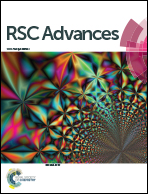Theoretical insights into a colorimetric azo-based probe to detect copper ions†
Abstract
In the present study, a colorimetric azobenzene-based probe (AZO 1) was reported that exhibits high selectivity toward Cu2+ and undergoes a red to yellow colour change upon its detection. Density functional theory (DFT) calculations were carried out to investigate the mechanism of the probe discoloration. The differences in the binding energies of complexes of 2 : 1 and 1 : 1 stoichiometry indicated that a two-step complexation process takes place as the Cu2+ content increases. However, the calculated absorption spectra suggested that a significant colour change would only be observed for the 1 : 1 AZO 1 : Cu2+ complex. A HOMO–LUMO electronic transition was a key factor for the blue shift of the absorption bands of the probe. Further studies indicated that solvent molecules participate in the complexation and that the presence of the o-methoxy group in AZO 1 led to formation of an octahedral complex because of the additional chelating site. A significant change in the conformation of AZO 1, namely the rotation of the N,N-di(carboxymethyl)amino group around the N–CAr bond by approximately 90°, resulted in a larger HOMO–LUMO energy gap, and the corresponding alteration of the intramolecular charge transfer (ICT) from the N,N-di(carboxymethyl)amino group to the phenyl ring led to the observed colour change.



 Please wait while we load your content...
Please wait while we load your content...